Roofing Companies Fremont
Find top Roofing Companies in Fremont
Receive up to 3 Roofers quotes for your project today! Compare profiles, reviews, accreditations, portfolio, etc... and choose the best deal.
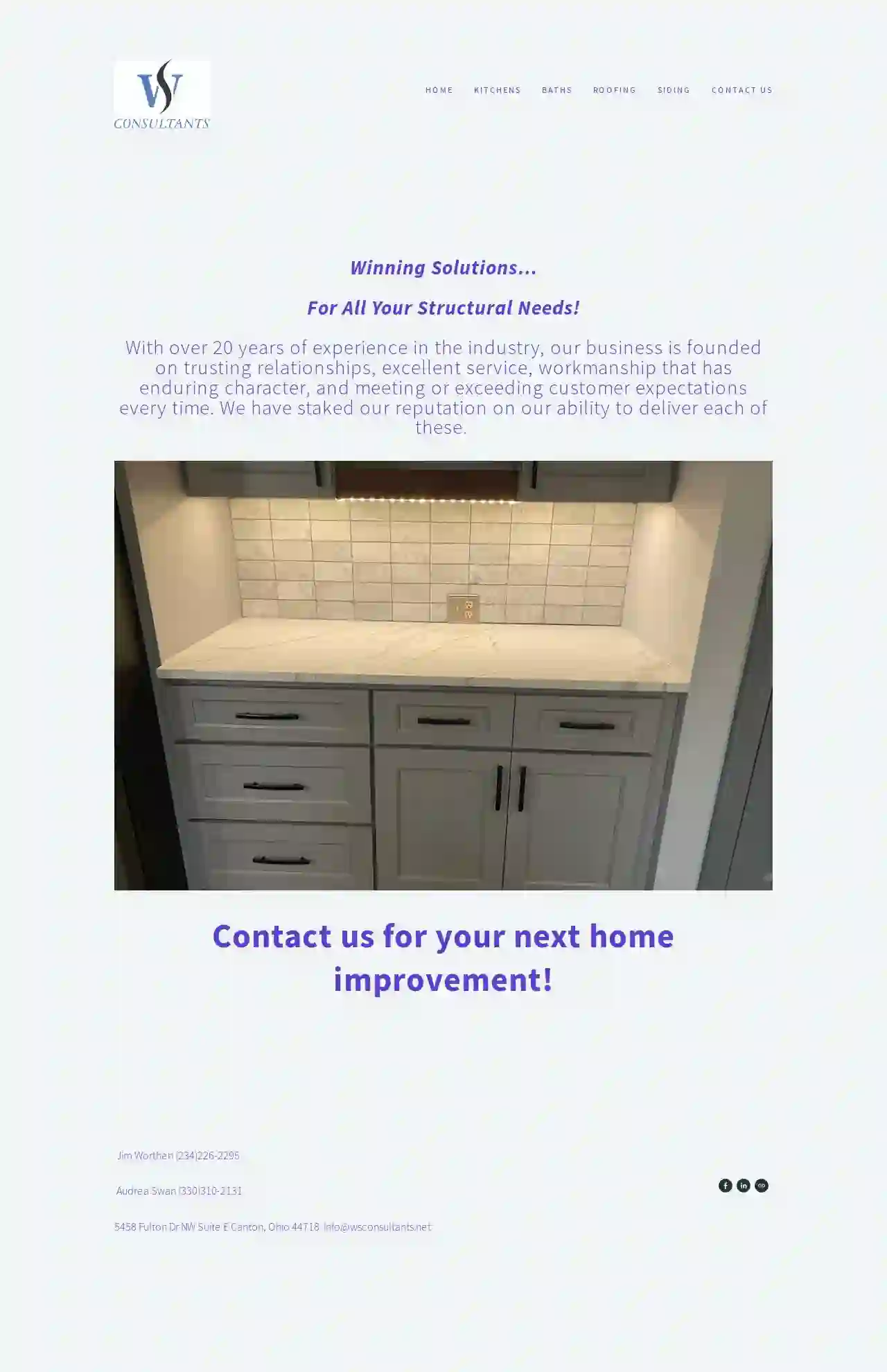
WS Consultants
510 reviews5458 Fulton Dr NW Suite E, Canton, 3303102131, USWith over 20 years of experience in the industry, our business is founded on trusting relationships, excellent service, workmanship that has enduring character, and meeting or exceeding customer expectations every time. We have staked our reputation on our ability to deliver each of these.
- Services
- Why Us?
- Our Team
- Gallery
Get Quote
Shingle And Metal Roofs, LLC
4.857 reviews5848 Dorr Street, Toledo, 43615, USHigh-quality Roofing runs in our family. With industry-leading warranties, easy financing options, and a commitment to exceptional customer service, we're the premier shingle and metal roofing company in Toledo, Ohio. Our family-owned business has been serving the community for generations, and we're dedicated to helping your home improvement dreams come true. Whether you need a new roof, siding, windows, or gutters, we've got you covered. Contact us today to schedule a consultation and let our family help you with your home improvement needs.
- Services
- Why Us?
- Accreditations
- Our Team
- Gallery
Get Quote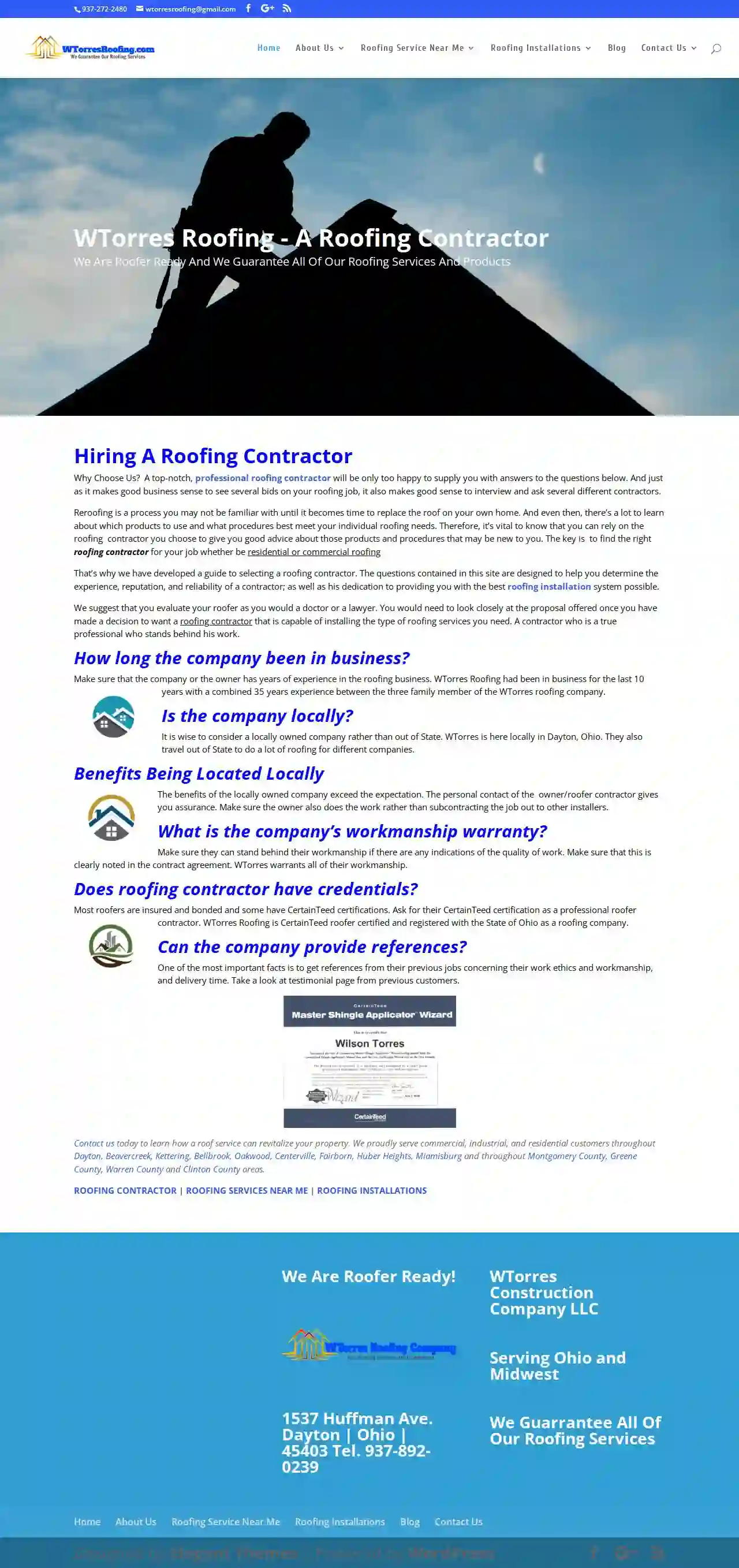
WTorres Roofing Company
3.52 reviews1537 Huffman Ave., Dayton, 45403, USWTorres Roofing - A Roofing Contractor We Are Roofer Ready And We Guarantee All Of Our Roofing Services And Products Hiring A Roofing Contractor Why Choose Us? A top-notch, professional roofing contractor will be only too happy to supply you with answers to the questions below. And just as it makes good business sense to see several bids on your roofing job, it also makes good sense to interview and ask several different contractors. Reroofing is a process you may not be familiar with until it becomes time to replace the roof on your own home. And even then, there’s a lot to learn about which products to use and what procedures best meet your individual roofing needs. Therefore, it’s vital to know that you can rely on the roofing contractor you choose to give you good advice about those products and procedures that may be new to you. The key is to find the right roofing contractor for your job whether be residential or commercial roofing That’s why we have developed a guide to selecting a roofing contractor. The questions contained in this site are designed to help you determine the experience, reputation, and reliability of a contractor; as well as his dedication to providing you with the best roofing installation system possible. We suggest that you evaluate your roofer as you would a doctor or a lawyer. You would need to look closely at the proposal offered once you have made a decision to want a roofing contractor that is capable of installing the type of roofing services you need. A contractor who is a true professional who stands behind his work. How long the company been in business? Make sure that the company or the owner has years of experience in the roofing business. WTorres Roofing had been in business for the last 10 years with a combined 35 years experience between the three family member of the WTorres roofing company. Is the company locally? It is wise to consider a locally owned company rather than out of State. WTorres is here locally in Dayton, Ohio. They also travel out of State to do a lot of roofing for different companies. Benefits Being Located Locally The benefits of the locally owned company exceed the expectation. The personal contact of the owner/roofer contractor gives you assurance. Make sure the owner also does the work rather than subcontracting the job out to other installers. What is the company’s workmanship warranty? Make sure they can stand behind their workmanship if there are any indications of the quality of work. Make sure that this is clearly noted in the contract agreement. WTorres warrants all of
- Services
- Why Us?
- Our Team
- Gallery
Get Quote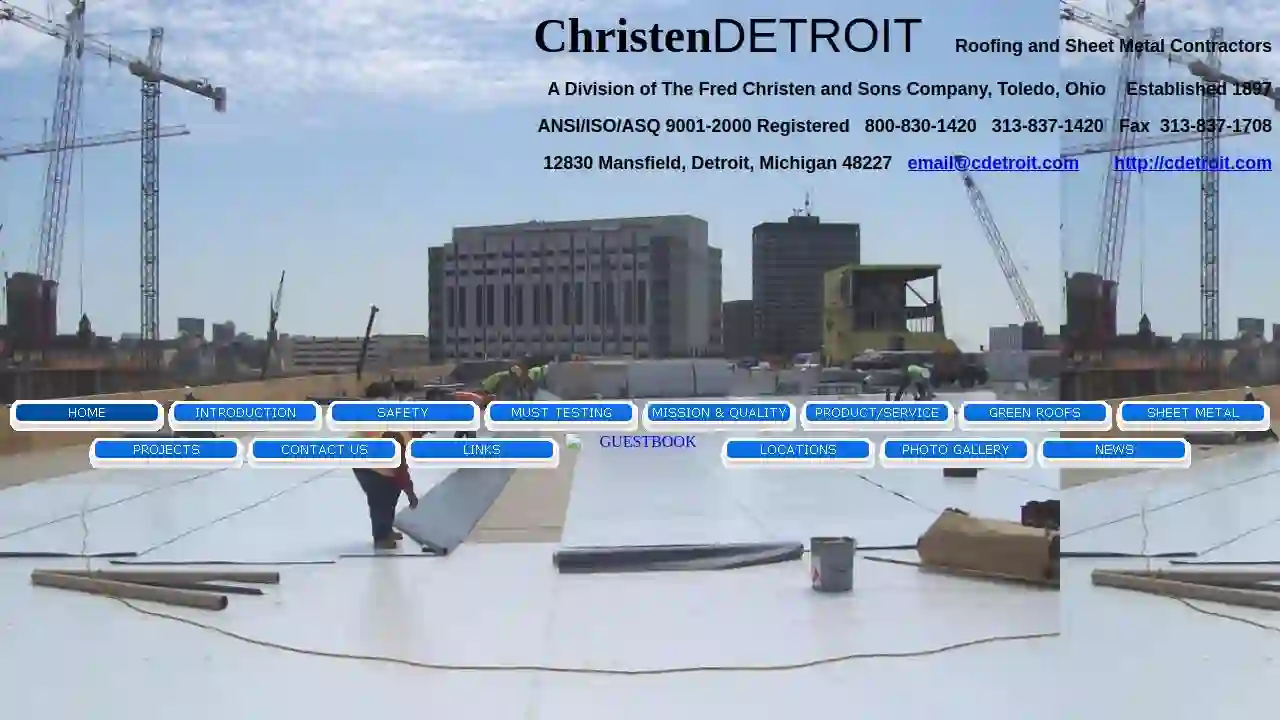
Fred Christen & Sons Co
3.711 reviews12830 Mansfield, Detroit, 48227, USFounded in 1897, The Fred Christen & Sons Co. of Toledo, Ohio has built a reputation for quality roofing and sheet metal installations. Now in its fourth generation of continuous family ownership, Christen craftsmanship is as evident today as it was a century ago. To fully service the international automotive and supplier markets, The Fred Christen & Sons Co. proudly introduced its Detroit branch in 1991. As ChristenDETROIT, we offer the same high standards of quality and timely installations that are the foundation of our Toledo organization. ChristenDETROIT operates a full service office and warehouse system in Detroit and has sent equipment, supervision, and manpower to complete work in seventeen states and Mexico. We are committed to equal opportunity to support a balanced minority and female workforce, and utilize minority partners for MBE participation. We function under a strict safety program with an excellent EMR. We offer the proven experience and capacity to complete projects ranging in size from minor repairs to three million square foot roof replacement. We are prepared to work to any required schedule: 24 hours per day, seven days a week. Built-up, single ply, or any type of roofing or sheet metal, commercial, institutional, or industrial, expect the highest standards from Christen. For 100 years, The Christen companies have focused on values that have proven successful: safety, timeliness, and long term performance. As an ISO 9002 registered contractor, we are committed to continuous improvement in the future as we link these core values with advancing technologies. Should you require maintenance, roofing renovation or new construction in Detroit, Toledo or throughout the United States and Mexico, consider Christen for quality and service.
- Services
- Why Us?
- Accreditations
- Gallery
Get Quote
EGC Roofing and Siding
52 reviews907 Spring Ave NE, Canton, 44704, USEGC Roofing and Siding is a premium roofing company serving Canton, Ohio, and the surrounding areas, including Stark County, Summit County, and Cuyahoga County. We specialize in a wide range of roofing services, from repairs and replacements to gutters, skylights, and more. We are proud of our high-quality work and commitment to providing hassle-free solutions for all your roofing and siding needs. We use only the best materials and work with experienced, licensed professionals to ensure a seamless experience for our customers. Our goal is to help you enjoy your roof for many years to come. We are your trusted local roofing company in the Canton, Ohio area.
- Services
- Why Us?
- Accreditations
- Our Team
- Testimonials
- Gallery
Get Quote
Lojas Home Improvement Plus LLC
4.975 reviews10 -12 Richards Street, Newark, 07105, USLoja’s Home Improvement Plus LLC in Newark, NJ, has a team of experienced home improvement specialists ready to help with your next project. Let our experienced professionals help with roofing repair, roofing installation, siding, gutter installation, framing and more. To get a free quote, give us a call today at 973-991-1949 or 973-415-4173.
- Services
- Why Us?
- Accreditations
- Our Team
- Testimonials
- Gallery
Get Quote
GreatWay Roofing Thousand Oaks
55 reviews622 Calle Plano, Camarillo, 93012, USGreatWay Roofing is an established and trusted Thousand Oaks roofing company that provides only the very best in craftsmanship and service. When you need a new roof, a roof repair or commercial roofing services, GreatWay Roofing is the company you can count on. We conduct our business in a manner that elevates how roofing contractors are perceived by individual homeowners and commercial clientele alike. Customer service is paramount at GreatWay Roofing Company. We've been roofing Ventura County California, West San Fernando Valley, and Santa Clarita Valley since 1999. We're Residential & Commercial Roofing Contractors that specialize in Roof Replacement and Roof Repair. In addition to our other roofing services, Roof Inspection and Roof Maintenance are important areas of service.
- Services
- Why Us?
- Accreditations
- Our Team
- Testimonials
- Gallery
Get Quote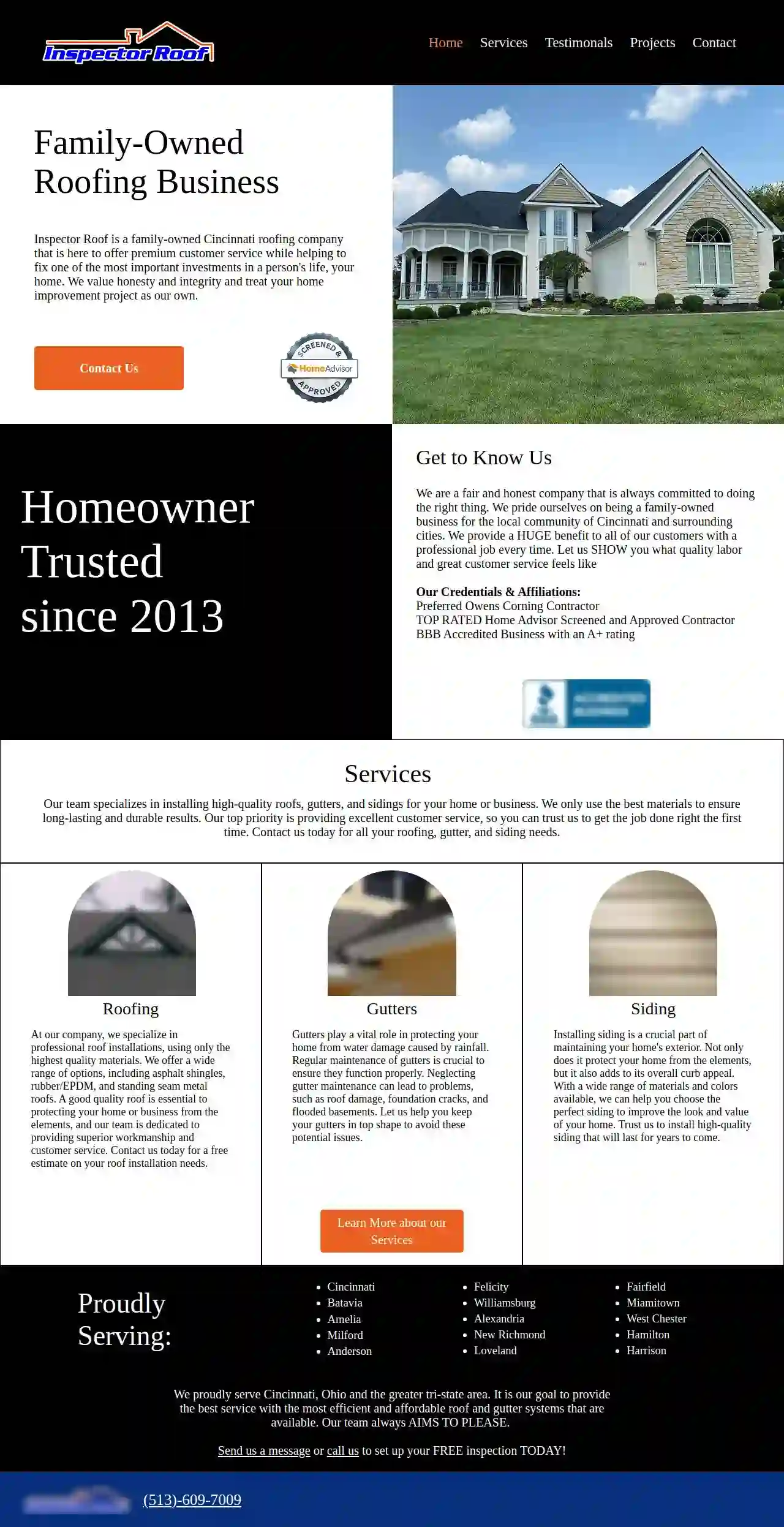
Inspector Roof, LLC
4.829 reviewsCincinnati, USInspector Roof is a family-owned Cincinnati roofing company dedicated to providing premium customer service while helping you protect one of your most valuable assets: your home. We believe in honesty and integrity, treating every home improvement project as if it were our own. Since 2013, we've been a trusted name in the Cincinnati community and surrounding cities, committed to delivering professional, high-quality work with every project. We pride ourselves on being a family-owned business that truly cares about our customers and their satisfaction. Let us demonstrate what exceptional labor and outstanding customer service feel like. Our Credentials & Affiliations: Preferred Owens Corning Contractor TOP RATED Home Advisor Screened and Approved Contractor BBB Accredited Business with an A+ rating
- Services
- Why Us?
- Accreditations
- Gallery
Get Quote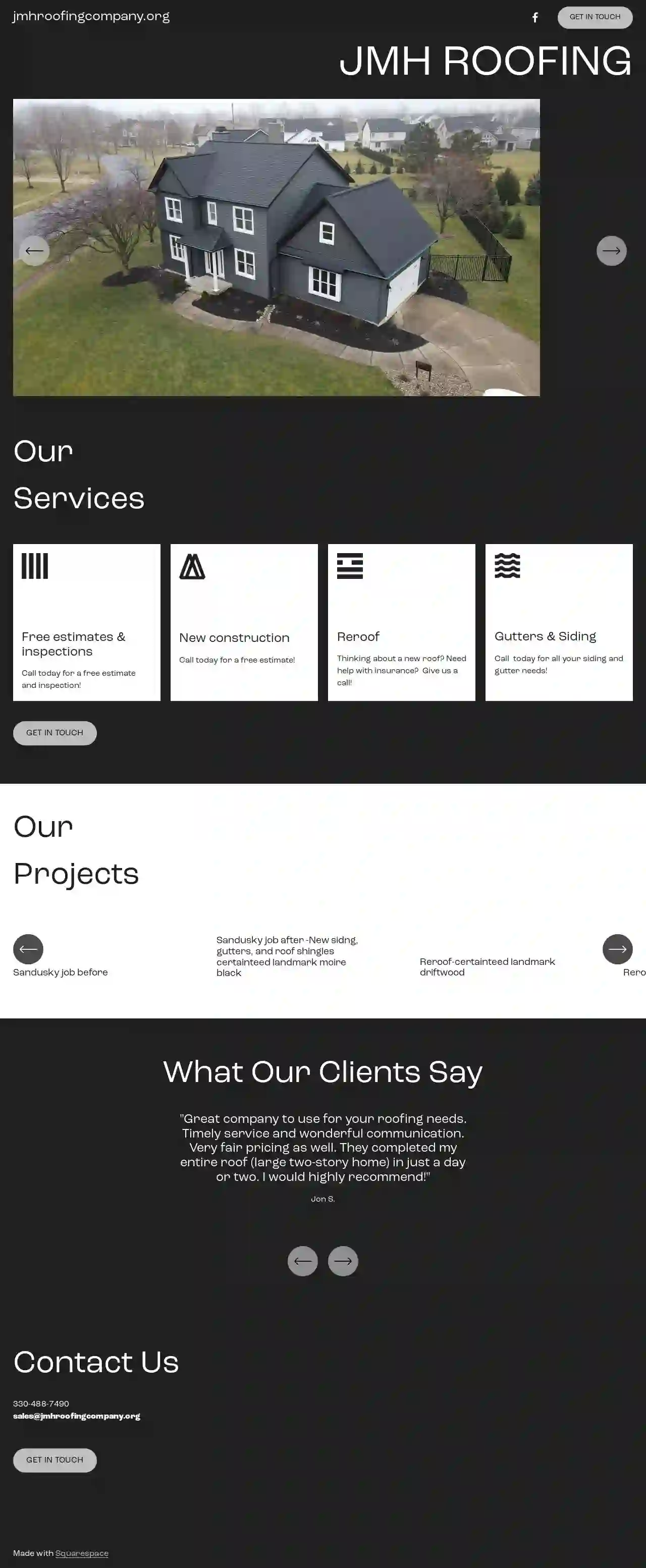
JMH Roofing
54 reviewsCanton, USJMH Roofing Company is a professional roofing and siding contractor serving the Sandusky area. With years of experience, we provide top-notch services including free estimates and inspections, new construction, reroofing, and gutter and siding installation. Our team is dedicated to delivering timely and quality work, ensuring customer satisfaction. We pride ourselves on our professionalism, prompt communication, and fair pricing. Contact us today to schedule your project inquiry!
- Services
- Why Us?
- Testimonials
- Gallery
Get Quote
Boak & Sons, Inc.
4.8136 reviews75 Victoria Rd, Youngstown, 44515, USFor nearly 50 years, Boak & Sons has been helping businesses and individuals save money on commercial and residential contracting projects. Get in touch with us to find out how much you could save.
- Services
- Why Us?
- Gallery
Get Quote
Over 17,196+ Roofing Businesses onboarded
Our roofing contractors operate in Fremont and surrounding areas!
Roofyng.com has curated and vetted the Best Roofers near Fremont. Find the most reliable business today.
Frequently Asked Questions About Roofing Companies
- Sagging or Pulling Away: Gutters that are sagging, pulling away from the house, or visibly damaged need repairs or replacement.
- Overflowing Water: If water overflows during rain, it indicates clogs or inadequate drainage.
- Visible Debris: Leaves, twigs, and other debris accumulated in the gutters obstruct water flow.
- Water Damage: Water stains or damage to siding or foundation near the gutters suggest overflow.
- Plant Growth: Plants or moss growing in the gutters indicate standing water and the need for cleaning.
- Asphalt Shingles: 20-30 years
- Metal Roofing: 40-70 years
- Tile Roofing: 50-100 years or more (clay and slate)
- Flat Roofing: 15-30 years (depending on material)
- Slate: 100 years or more
- Wood Shakes or Shingles: 30-50 years (with proper maintenance)
- Experience: Companies with a solid track record and years of experience in the industry.
- Licensing and Insurance: Verify they are properly licensed to operate in your area and carry adequate insurance to protect you from liability.
- Certifications: Look for certifications from reputable organizations, demonstrating expertise in specific roofing materials or techniques.
- Positive Reviews: Check online reviews and testimonials from previous customers.
- Professionalism: Choose a company that communicates clearly, provides detailed estimates, and has a courteous and responsive team.
How can I tell if my gutters need to be cleaned or repaired?
How long does a roof typically last?
How do I find a good roofing company?
What is fascia, and why is it important?
How can I tell if my gutters need to be cleaned or repaired?
- Sagging or Pulling Away: Gutters that are sagging, pulling away from the house, or visibly damaged need repairs or replacement.
- Overflowing Water: If water overflows during rain, it indicates clogs or inadequate drainage.
- Visible Debris: Leaves, twigs, and other debris accumulated in the gutters obstruct water flow.
- Water Damage: Water stains or damage to siding or foundation near the gutters suggest overflow.
- Plant Growth: Plants or moss growing in the gutters indicate standing water and the need for cleaning.
How long does a roof typically last?
- Asphalt Shingles: 20-30 years
- Metal Roofing: 40-70 years
- Tile Roofing: 50-100 years or more (clay and slate)
- Flat Roofing: 15-30 years (depending on material)
- Slate: 100 years or more
- Wood Shakes or Shingles: 30-50 years (with proper maintenance)
How do I find a good roofing company?
- Experience: Companies with a solid track record and years of experience in the industry.
- Licensing and Insurance: Verify they are properly licensed to operate in your area and carry adequate insurance to protect you from liability.
- Certifications: Look for certifications from reputable organizations, demonstrating expertise in specific roofing materials or techniques.
- Positive Reviews: Check online reviews and testimonials from previous customers.
- Professionalism: Choose a company that communicates clearly, provides detailed estimates, and has a courteous and responsive team.